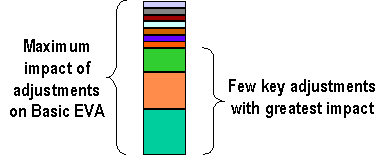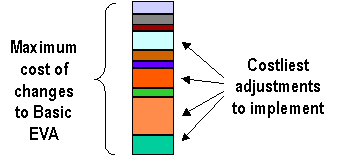Trade-offs in Selecting Potential Adjustments
An EP measure that included all possible adjustments would, in theory, come closest to a measure that perfectly reflects the value of the company from one period to the next.
It would also be an unnecessarily burdensome measure to track and understand.
Quantifying the Benefits
In reality, a few key adjustments can get us most of the benefits of improved measurement. All other potential adjustments may prove relatively immaterial. In other words, they may not make enough of a difference to drive behavior.

Whether looking at the size of the adjustment's effect, it's cumulative, incremental impact on decision making, or how well the adjusted versus unadjusted measure tracks market value, in the end the decision makers will have to assess the materiality of each adjustment, and of all of them together, with regards to their impact on behavior. There is no formula for this. This judgment will require a deep understanding of how behaviors might react to, and drive, the financial results relfected in EP.
Quantifying the Costs
The net costs born by the company to implement adjustments can be just as difficult to quantify, accounting for both data availability and complexity.

Data availability may be a function of both start-up costs, e.g., to set up schedule that are not required by traditional accounting, and ongoing costs, e.g., reports and discussions of EP performance alongside other reports.
Complexity would be measured from three perspectives:
- The providers of financial information (finance department or controllers),
- The internal users of the financial information (operating managers), and
- The outside users of financial information (board and investment community).
Financial managers tend to be most sensitive to the costs of setting up and maintaining the systems to implement a new measure, but tend to way underestimate the cost of getting and keeping their operating colleagues up to speed on how the measure should behave relative to their activities. Boards of directors and external analysts tend to have even less patience for the nuances of managerial accounting.
A Bias Toward Simplicity
Given the 80/20 rule that applies so widely in business, it is wise to at least begin life under an EP measure with something that looks as close as possible to a bottom line measure that your managers are already familiar with. This bias toward familiarity should be strengthened by the fact that certain adjustments will cost the providers of the data significant time, and some money, to implement. Plus, the company will bear a cost in compromised decisions and confidence by enforcing a measure that looks too "black box" to its users, no matter how much is invested in getting them to understand it.
In surveys of dozens of companies that have implemented EP or EVA, the number two reason they ended up dropping it was that it was "too complicated" for the management and the board to understand. The companies that have kept their EP measures in place for years and, in some cases decades, kept it simple, updated it as necessary, and invested in ongoing training their operating managers (i.e., the users) in how to use it for decision making